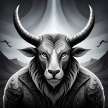
In the rich tapestry of Hungarian folklore, there are captivating legends that echo through the ages. Two such stories, "Attila's Cup" and the "Hunor-Magor Legend," offer glimpses into Hungary's ancient past, filled with mystery, romance, and the origins of its people. Join us as we delve into these tales of wonder and heritage.
Attila's Cup: The Golden Bull Head Bowl
Deep within the annals of history lies the story of Attila the Hun, the infamous "Scourge of the Roman Legions." In the year 453 AD, on his wedding night, Attila met an improbable and tragic end. As he engaged in intimate relations with one of his many wives, a burst blood vessel condemned him to suffocate in his own blood and vomit, a consequence of excessive alcohol consumption. Thus, Attila passed into history, thanks to the chroniclers of the time. However, some claim that he met his demise at the hands of his new wife, forever shrouded in mystery. This event unfolded in what is now the territory of present-day Hungary 🇭🇺.
The Hunor-Magor Legend: An Ancient Bond
The Hunor-Magor legend is a well-known Hungarian tale recorded initially in the 13th century and later in the 14th century. It narrates the origins and kinship between the Hungarians and the Huns.
According to the legend, after the death of their father, the two brothers Hunor and Magor embarked on a hunting expedition with a hundred horsemen beyond their domains. During their long hunt, a majestic deer leaped before them. This was the Marvelous Stag or Prodigal Stag (in Hungarian: csodaszarvas), a mythical creature described differently in various sources. Some depict it always surrounded by an aura of light, while others simply portray it as a white deer. In the settlement of Bulcsu, Hungary, it is remembered for having the sun between its thousand antlers, each tipped with a candle.
The two brothers pursued the deer relentlessly day and night but failed to capture it. After trailing it for a long time, they eventually lost its trail and returned home, never to encounter the deer again. They decided to set up camp in a nearby forest to rest and plan their next move when, in the silence of the night, Hunor and Magor heard enchanting music. Curious about its source, they followed the sound to a clearing in the forest, where fairies were engaged in a mesmerizing dance. Startled by the brothers' arrival, the two central maidens, daughters of the Alan Prince Dul, fled in fear. Hunor and Magor pursued them, ultimately capturing and marrying them, just as their men did with the remaining one hundred maidens.
As the descendants of Hunor multiplied, they became the Huns, while Magor's offspring became the Magyar people (Hungarians). When there was not enough space for both nations, it was decided that the descendants of Hunor would travel eastward, and Magor's descendants would journey westward. According to the legend, the Huns determined that to find the direction guided by the gods, a blind man had to spin the sword of the gods seven times and throw it. But the wind caught the sword, and both nations set forth toward the west. It was thus that Attila the Hun discovered the sword of the gods, cast near the Tisza River, leading them to settle in the region of present-day Hungary.
With their destinies set, the descendants of Hunor and Magor embarked on their separate journeys, guided by the winds of fate. The Hunnic tribes, under the leadership of Attila, ventured eastward, traversing vast lands and leaving their mark in the pages of history as a formidable force. Meanwhile, the Magyar people, led by their own leaders, embarked on a westward migration, carrying with them the ancient tales and traditions of their ancestors.
The path of the Huns led them through the vast steppes of Eurasia, where they established their dominion and encountered diverse cultures along the way. Their exploits and conquests became the stuff of legends, as they clashed with mighty empires and carved out their own realm of power. Attila, with his strategic brilliance and ferocious warriors, became a symbol of both fear and awe, leaving an indelible imprint on the annals of history.
On the other hand, the Magyar people's westward journey took them through challenging landscapes and encounters with different peoples. They forged alliances, adapted to new environments, and preserved their unique identity and language. Ultimately, they settled in the land that would become their homeland, Hungary, building a vibrant culture and society that blended their own heritage with the influences they encountered along their migratory path.
The tales of Hunor and Magor, intertwined with the legendary figure of Attila the Hun, continue to echo through the ages, reminding the Hungarian people of their ancient origins and the resilience of their ancestors. These legends serve as a testament to the enduring spirit and rich heritage of Hungary, captivating both locals and visitors alike.
As we delve deeper into the realms of Hungarian folklore, we uncover more enchanting stories and mystical sagas that reveal the depths of the nation's history and its cultural tapestry. Join us on this journey of exploration and discovery, as we unravel the tapestry of legends and myths that have shaped the land of Hungary for centuries.






Comments
There are no comments for this story
Be the first to respond and start the conversation.